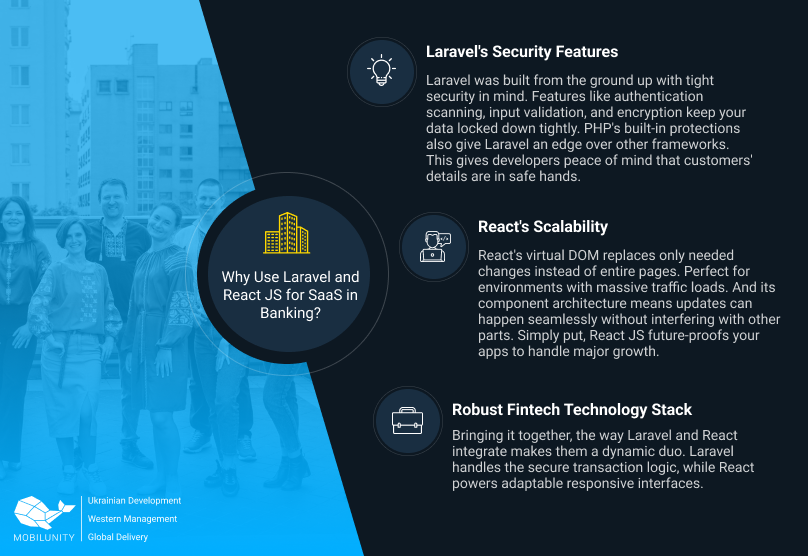Laravel and React JS: SaaS Solution for Banking and Finance Industry

The whole idea of Software as a Service has changed how we make and use business tools today. Being able to plug into programs online has helped industries like banking and finance a lot. Did you know finance software makes the most money from SaaS, bringing in almost 26 billion dollars? People working in these areas are always trying to update stuff for customers anywhere, anytime on different devices.
Laravel and React JS are also good options for building powerful apps for competitive fields. Laravel is the second most popular PHP skill – more than 39% of developers worldwide like it. React JS parts are helpful for dynamic screens – 40.6% of programmers use it.
In this article, we’ll look at how using Laravel and React JS together can make top-quality SaaS programs for finance.
Understanding Laravel and React JS
Let’s get the rundown on Laravel and React. To start with, Laravel is an open-source PHP framework that handles server-side coding, making it so you can build full web apps quickly. This framework is used by almost 2 million websites. A few key facts:
- Laravel rocks the MVC (Model-View-Controller) structure to separate your code neatly into models, views, and controllers.
- Comes packed with commonly needed tools for routing, databases, sessions, and caching all built right in.
- Saves developers a ton of time from having to set all that grunt work up manually.
Where Laravel builds out the application backbone, React JS is a JavaScript library solely focused on the front-end UI. It is the 2nd most popular JS library on the entire Internet.
In essence:
- React JS chops your interface layout into reusable component blocks that receive data inputs and display the visual outputs.
- Has become huge, especially in building intricate user interfaces for more complex apps, like many used in the financial tech world.
- Lets mobile developers write the code once and have it run seamlessly across different platforms.
So in summary, Laravel handles wiring up the structural foundation and business logic server side. This allows developers to then focus energy on the functionality. Meanwhile, React JS takes care of putting together great-looking, rapidly updating interfaces that keep users engaged. Together they provide the full tech stack for fintech to whip up robust SaaS products and applications with high-caliber backend and frontend designs.
The combination of Laravel’s organization and quick development balanced with React’s dynamic interfaces has made it a dream team for many successful SaaS-based companies.
Why Use Laravel and React JS for SaaS in Banking?
Security and scalability are make-or-break for any finance tech. That’s why the Laravel and React combo is part of the fintech stack for SaaS in banking.
- Laravel’s Security Features. Laravel was built from the ground up with tight security in mind. Features like authentication scanning, input validation, and encryption keep your data locked down tightly. PHP’s built-in protections also give Laravel an edge over other frameworks. This gives developers peace of mind that customers’ details are in safe hands.
- React’s Scalability. React’s virtual DOM replaces only needed changes instead of entire pages. Perfect for environments with massive traffic loads. And its component architecture means updates can happen seamlessly without interfering with other parts. Simply put, React JS future-proofs your apps to handle major growth.
- Laravel’s Security + React’s Scalability = Robust Fintech Technology Stack. Bringing it together, the way Laravel and React integrate makes them a dynamic duo. Laravel handles the secure transaction logic, while React powers adaptable responsive interfaces.
In industries like finance and banking, reliability is job one. By choosing solutions with built-in security and performance like Laravel and React, developers stay focused on creating innovative solutions.
Building a SaaS Application with Laravel and React JS
Now that we know Laravel and React JS work well for fintech software, let’s take a look at what it takes to build it.
- The back (Laravel) centers on key things like signing in, finding data, and working well. It shares what’s needed through APIs.
- The front (React) is what users interact with. It uses the back APIs. To connect with Laravel, React sends data through JSON requests.
Splitting the work between frontend and backend can go easily when getting help from Laravel consultants and available React JS developers. In particular, Laravel helpers efficiently manage backend tasks, while React ensures a fast and smooth frontend experience. User authentication happens through the Laravel API, with React dynamically requesting data as needed. Information is securely exchanged as JSON, with security measures such as encryption, authentication safeguards, and authorization checks in place. Additionally, SSL plays a crucial role in protecting transmitted data.
By splitting it out this way and connecting where needed, Laravel and React can build powerful programs for banking and finance that run smoothly.
Potential Challenges
Building SaaS presents several potential challenges:
- Development and Deployment. Keeping the front and back parts working together well is one thing to watch. In particular, new versions of both technologies could mess up how they connect, while customers need the software running all the time. Deploying changes means thinking about not stopping the software. The solution is automation and testing before going live. These help lower the chances of problems when adding new features.
- Compliance with Financial Regulations. Rules also vary a lot in different locations and markets. Making sure to follow private info, security, and reporting laws everywhere means thinking it through upfront.
- Data Privacy and Security. Hackers constantly hunt for weak spots in important programs. Sensitive customer data indicates that constant checks and fast updates are vital. However, audits help reassure clients of protection.
Thus, proper planning can handle all of these challenges to make sure the software meets high standards for years with Laravel and React JS together.
Mobilunity’s Case Study
This case study tells about how we at Mobilunity helped a big UK bank that required immediate assistance. They needed to build a new online banking app but were short on people with the right skills. They wanted to hire Laravel developers for the back end and to hire React JS developers for the front end of the app.
- First, we searched our talent database for matches. Then we reached out to people we knew and platforms like LinkedIn and Job Boards. We found some possible candidates.
- After looking at over 30 people, we interviewed 21 (while 25 candidates were interested, not all had specific experience or knew about regulations). We also held online meetings to further assess their qualifications and compatibility with the team.
- The deadline was tight. Through technical screenings, assessments for cultural fit, and client interviews, we were able to hire two developers within three weeks. Both knew the technologies asked for and followed industry rules. With our help getting started, they adapted to the new job fast.
It was challenging for us to find the right people quickly with high standards. In the end, our methods allowed us to help the bank stay on track and meet its goals efficiently.
How Our Recruiters Approach the Search
When we’re helping clients find the perfect engineers, it’s an intensive process from start to finish.
- First things first, we try to understand exactly what our clients are looking for and why. You’d be surprised how the details they give upfront aren’t always the full picture.
- After that homework is done, it’s time to make sure any candidates we find are a true match for the job in terms of experience and skills.
- That’s when the search begins. We use our contacts and network on employment-focused social media platforms.
- Once we find possible matches, it’s time to start narrowing them down. A candidate screening and initial assessment help determine who is in or out before wasting anyone’s time with lengthy interviews.
- Then the technical assessment begins for the remaining candidates.
- Cultural fit is important too when it comes to working with both clients and teammates long-term. That’s why we make sure to meet candidates in person when possible so we get a true feel for who they are.
- After that, we dig into their technical skills through in-depth questions or sample work.
- Then qualified candidates speak to clients to see if they’ll be a good long-term partner for projects.
- If all goes well through this process, clients make an offer and start onboarding. It takes thorough matching at each stage.
If everything’s okay, both clients and recruits sign a contract and begin working together. When the whole process is a success, we can celebrate a new project partnership in the making.
Mobilunity – Your Reliable Partner
To wrap up, hope this gives you a good idea of why Mobilunity is a trusted partner for finding top fintech talent. We started way back in 2010. Over 40 different companies in lots of places reached out to us and were happy.
Our recruiters know how to find specialists anywhere you need. They always find people with the skills you want. Thus, we’ve helped lots of clients get the people they need for finance tech before. Clients could make new products or get more coding done thanks to who we found.
There are two main ways to work with us:
- If your project is big with many tasks, a whole dedicated professional team just for you might be best. We’ll set it all up and take care of the team.
- If your project is small with a small load, then our part-time technical consultants can give you the help you need on a flexible basis.
No matter what works best for you, trust that Mobilunity has experience and connections worldwide. Feel free to talk to us about finding top finance tech talent for your project!
FAQ
- How do Laravel and React JS help make software as a service (SaaS)?
They go together well. Laravel is a fast PHP program used to build apps. React JS lets you make dynamic, changing pages in JavaScript. Together they speed up making SaaS software.
- What security features does Laravel offer banking apps?
Laravel includes security features like encryption and HTTPS that financial apps need. It also lets you manage user permissions to keep data private for banks.
- Why choose React JS for banking SaaS frontend design?
A React JS banking application has dynamic interfaces and is very quick. Users expect snappy designs and loads of features, and React lets developers easily make all that happen.
- Can Laravel and React JS work together?
Yes, they connect well through APIs. Laravel provides JSON info that React JS uses to smoothly show and swap data on pages.
- What challenges come with using Laravel and React JS for finance SaaS?
Keeping security between the two is hard. Testing is complex too. Plus, learning both skills takes time. However, good planning can meet all of these hurdles.
- How can I start a SaaS app with Laravel and React JS?
The first step is to build the Laravel part, and then connect it to React. The next steps are to add features, get feedback, and keep improving as you go. Meanwhile, having financial software consultants help will make onboarding the tech much quicker.

















